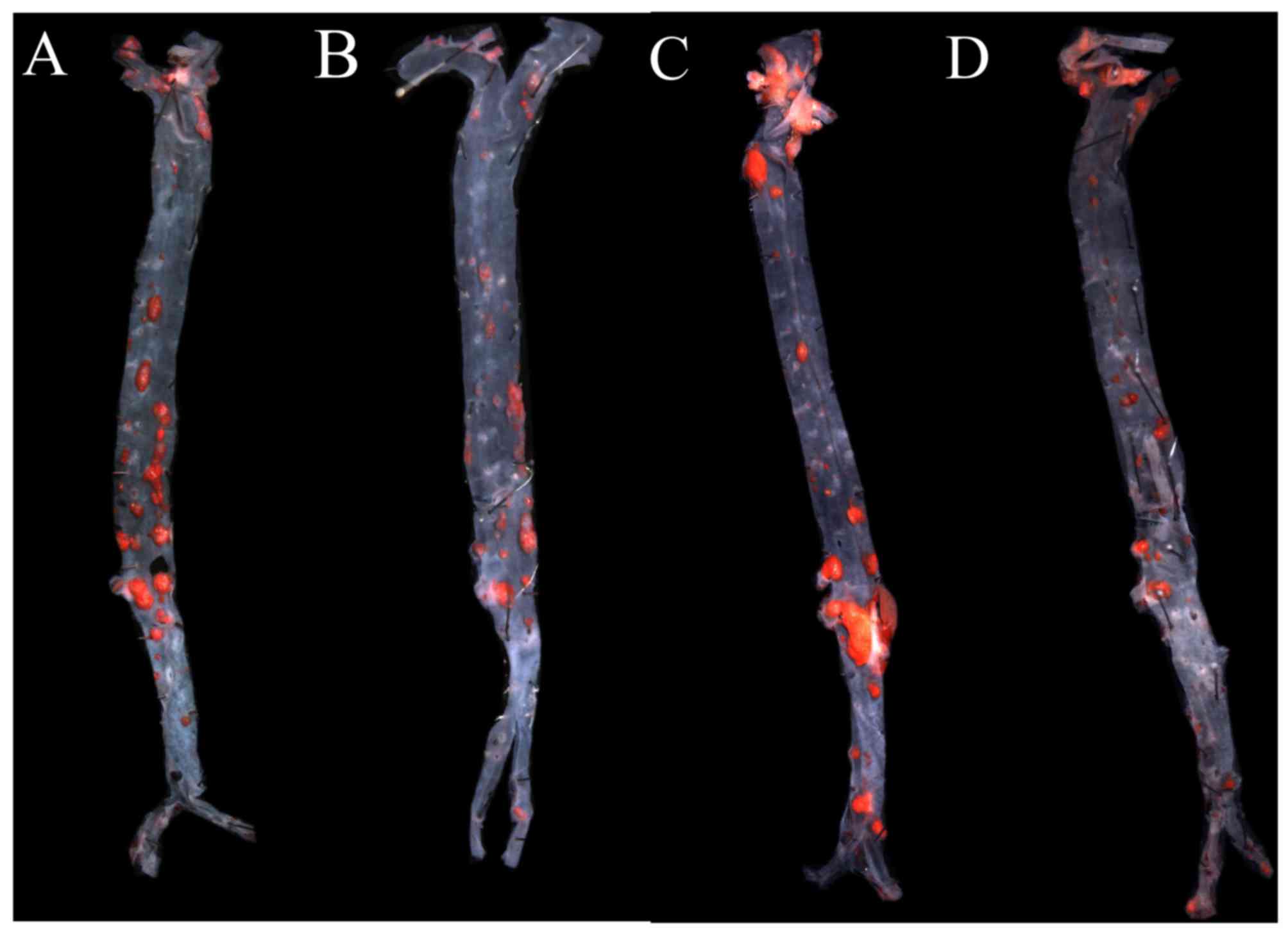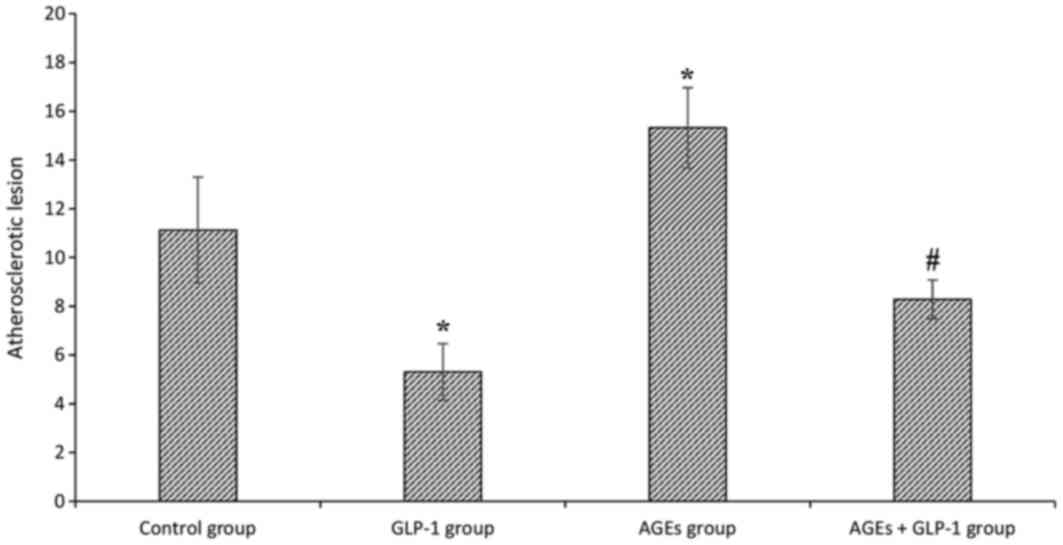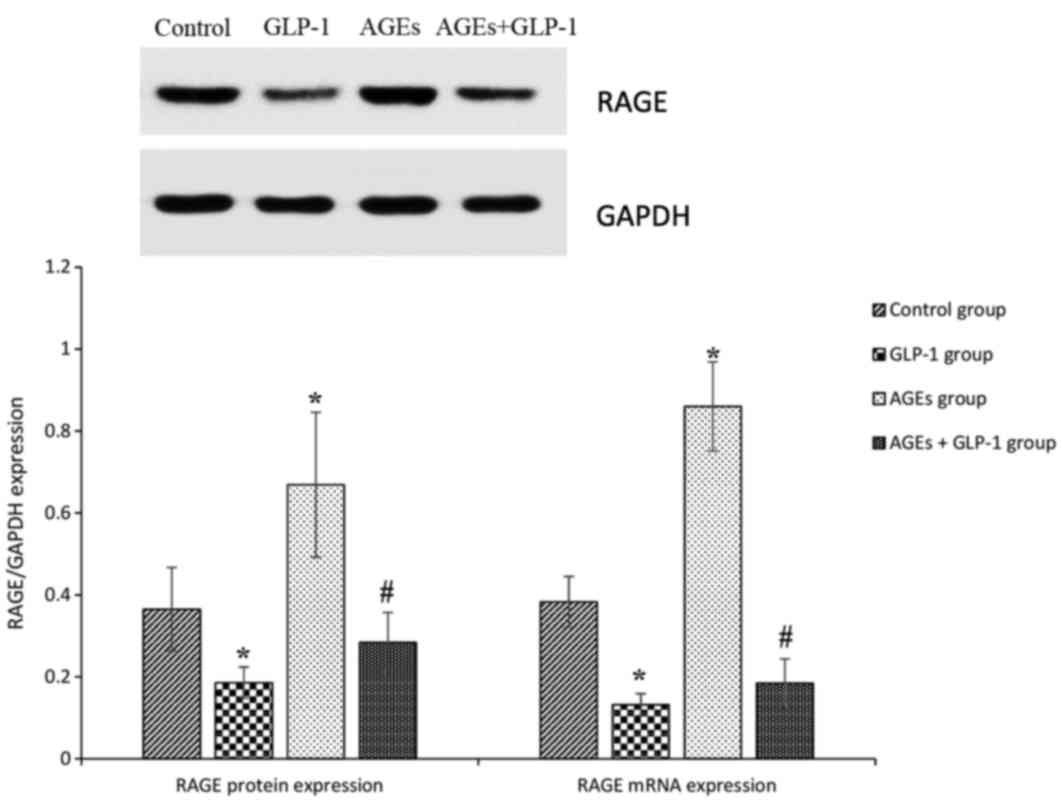|
1
|
Whiting DR, Guariguata L, Weil C and Shaw
J: IDF diabetes atlas: Global estimates of the prevalence of
diabetes for 2011 and 2030. Diabetes Res Clin Pract. 94:311–321.
2011. View Article : Google Scholar : PubMed/NCBI
|
|
2
|
Haffner SM, Lehto S, Rönnemaa T, Pyörälä K
and Laakso M: Mortality from coronary heart disease in subjects
with type 2 diabetes and in nondiabetic subjects with and without
prior myocardial infarction. N Engl J Med. 339:229–234. 1998.
View Article : Google Scholar : PubMed/NCBI
|
|
3
|
Fowler MJ: Microvascular and Macrovascular
Complications of Diabetes. Clinical Diabetes. 26:77–82. 2008.
View Article : Google Scholar
|
|
4
|
Scheen AJ and Paquot N: Blood glucose
control and prevention of microangiopathy and macroangiopathy in
type 2 diabetes. Rev Med Liege. 58:265–270. 2003.PubMed/NCBI
|
|
5
|
Wang Y, Parlevliet ET, Geerling JJ, van
der Tuin SJ, Zhang H, Bieghs V, Jawad AH, Shiri-Sverdlov R, Bot I,
de Jager SC, et al: Exendin-4 decreases liver inflammation and
atherosclerosis development simultaneously by reducing macrophage
infiltration. Br J Pharmacol. 171:723–734. 2014. View Article : Google Scholar : PubMed/NCBI
|
|
6
|
Dozier KC, Cureton EL, Kwan RO, Curran B,
Sadjadi J and Victorino GP: Glucagon-like peptide-1 protects
mesenteric endothelium from injury during inflammation. Peptides.
30:1735–1741. 2009. View Article : Google Scholar : PubMed/NCBI
|
|
7
|
le Kim Chung T, Hosaka T, Yoshida M,
Harada N, Sakaue H, Sakai T and Nakaya Y: Exendin-4, a GLP-1
receptor agonist, directly induces adiponectin expression through
protein kinase A pathway and prevents inflammatory adipokine
expression. Biochem Biophys Res Commun. 390:613–618. 2009.
View Article : Google Scholar : PubMed/NCBI
|
|
8
|
Yamagishi S: Role of advanced glycation
end products (AGEs) and receptor for AGEs (RAGE) in vascular damage
in diabetes. Exp Gerontol. 46:217–224. 2011. View Article : Google Scholar : PubMed/NCBI
|
|
9
|
Huttunen HJ, Fages C and Rauvala H:
Receptor for advanced glycation end products (RAGE)-mediated
neurite outgrowth and activation of NF-kappaB require the
cytoplasmic domain of the receptor but different downstream
signaling pathways. J Biol Chem. 274:19919–19924. 1999. View Article : Google Scholar : PubMed/NCBI
|
|
10
|
Bierhaus A, Schiekofer S, Schwaninger M,
Andrassy M, Humpert PM, Chen J, Hong M, Luther T, Henle T, Klöting
I, et al: Diabetes-associated sustained activation of the
transcription factor nuclear factor-kappaB. Diabetes. 50:2792–2808.
2001. View Article : Google Scholar : PubMed/NCBI
|
|
11
|
Cipollone F, Iezzi A, Fazia M, Zucchelli
M, Pini B, Cuccurullo C, De Cesare D, De Blasis G, Muraro R, Bei R,
et al: The receptor RAGE as a progression factor amplifying
arachidonate-dependent inflammatory and proteolytic response in
human atherosclerotic plaques: Role of glycemic control.
Circulation. 108:1070–1077. 2003. View Article : Google Scholar : PubMed/NCBI
|
|
12
|
Park L, Raman KG, Lee KJ, Lu Y, Ferran LJ
Jr, Chow WS, Stern D and Schmidt AM: Suppression of accelerated
diabetic atherosclerosis by the soluble receptor for advanced
glycation endproducts. Nat Med. 4:1025–1031. 1998. View Article : Google Scholar : PubMed/NCBI
|
|
13
|
Feng B, Xu L, Wang H, Yan X, Xue J, Liu F
and Hu JF: Atorvastatin exerts its anti-atherosclerotic effects by
targeting the receptor for advanced glycation end products. Biochim
Biophys Acta. 1812:1130–1137. 2011. View Article : Google Scholar : PubMed/NCBI
|
|
14
|
Vlassara H, Striker LJ, Teichberg S, Fuh
H, Li YM and Steffes M: Advanced glycation end products induce
glomerular sclerosis and albuminuria in normal rats. Proc Natl Acad
Sci USA. 91:11704–11708. 1994. View Article : Google Scholar : PubMed/NCBI
|
|
15
|
Livak KJ and Schmittgen TD: Analysis of
relative gene expression data using real-time quantitative PCR and
the 2(−Delta Delta C(T)) method. Methods. 25:402–408. 2001.
View Article : Google Scholar : PubMed/NCBI
|
|
16
|
Yagyu H, Ishibashi S, Chen Z, Osuga J,
Okazaki M, Perrey S, Kitamine T, Shimada M, Ohashi K, Harada K, et
al: Overexpressed lipoprotein lipase protects against
atherosclerosis in apolipoprotein E knockout mice. J Lipid Res.
40:1677–1685. 1999.PubMed/NCBI
|
|
17
|
Chrysant SG and Chrysant GS: Clinical
implications of cardiovascular preventing pleiotropic effects of
dipeptidyl peptidase-4 inhibitors. Am J Cardiol. 109:1681–1685.
2012. View Article : Google Scholar : PubMed/NCBI
|
|
18
|
Arakawa M, Mita T, Azuma K, Ebato C, Goto
H, Nomiyama T, Fujitani Y, Hirose T, Kawamori R and Watada H:
Inhibition of monocyte adhesion to endothelial cells and
attenuation of atherosclerotic lesion by a glucagon-like peptide-1
receptor agonist, exendin-4. Diabetes. 59:1030–1037. 2010.
View Article : Google Scholar : PubMed/NCBI
|
|
19
|
Knudsen LB: Liraglutide: The therapeutic
promise from animal models. Int J Clin Pract Suppl. 4–11. 2010.
View Article : Google Scholar : PubMed/NCBI
|
|
20
|
Vlassara H and Palace MR: Diabetes and
advanced glycation endproducts. J Intern Med. 251:87–101. 2002.
View Article : Google Scholar : PubMed/NCBI
|
|
21
|
Fukami K, Yamagishi S and Okuda S: Role of
AGEs-RAGE system in cardiovascular disease. Curr Pharm Des.
20:2395–2402. 2014. View Article : Google Scholar : PubMed/NCBI
|
|
22
|
Yamagishi S, Fukami K and Matsui T:
Crosstalk between advanced glycation end products (AGEs)-receptor
RAGE axis and dipeptidyl peptidase-4-incretin system in diabetic
vascular complications. Cardiovasc Diabetol. 14:22015. View Article : Google Scholar : PubMed/NCBI
|
|
23
|
Sourris KC and Forbes JM: Interactions
between advanced glycation end-products (AGE) and their receptors
in the development and progression of diabetic nephropathy-are
these receptors valid therapeutic targets. Curr Drug Targets.
10:42–50. 2009. View Article : Google Scholar : PubMed/NCBI
|
|
24
|
Daffu G, del Pozo CH, O'Shea KM,
Ananthakrishnan R, Ramasamy R and Schmidt AM: Radical roles for
RAGE in the pathogenesis of oxidative stress in cardiovascular
diseases and beyond. Int J Mol Sci. 14:19891–19910. 2013.
View Article : Google Scholar : PubMed/NCBI
|
|
25
|
Kim W and Egan JM: The role of incretins
in glucose homeostasis and diabetes treatment. Pharmacol Rev.
60:470–512. 2008. View Article : Google Scholar : PubMed/NCBI
|
|
26
|
Ishibashi Y, Matsui T, Takeuchi M and
Yamagishi S: Glucagon-like peptide-1 (GLP-1) inhibits advanced
glycation end product (AGE)-induced up-regulation of VCAM-1 mRNA
levels in endothelial cells by suppressing AGE receptor (RAGE)
expression. Biochem Biophys Res Commun. 391:1405–1408. 2010.
View Article : Google Scholar : PubMed/NCBI
|
|
27
|
Chen S, Yin L, Xu Z, An FM, Liu AR, Wang
Y, Yao WB and Gao XD: Inhibiting receptor for advanced glycation
end product (AGE) and oxidative stress involved in the protective
effect mediated by glucagon-like peptide-1 receptor on AGE induced
neuronal apoptosis. Neurosci Lett. 612:193–198. 2016. View Article : Google Scholar : PubMed/NCBI
|
|
28
|
Hudson BI, Harja E, Moser B and Schmidt
AM: Soluble levels of receptor for advanced glycation endproducts
(sRAGE) and coronary artery disease: The next C-reactive protein?
Arterioscler Thromb Vasc Biol. 25:879–882. 2005. View Article : Google Scholar : PubMed/NCBI
|
|
29
|
Basta G, Sironi AM, Lazzerini G, Del Turco
S, Buzzigoli E, Casolaro A, Natali A, Ferrannini E and Gastaldelli
A: Circulating soluble receptor for advanced glycation end products
is inversely associated with glycemic control and S100A12 protein.
J Clin Endocrinol Metab. 91:4628–4634. 2006. View Article : Google Scholar : PubMed/NCBI
|
|
30
|
Falcone C, Emanuele E, D'Angelo A, Buzzi
MP, Belvito C, Cuccia M and Geroldi D: Plasma levels of soluble
receptor for advanced glycation end products and coronary artery
disease in nondiabetic men. Arterioscler Thromb Vasc Biol.
25:1032–1037. 2005. View Article : Google Scholar : PubMed/NCBI
|
|
31
|
Ratajczak MZ, Zuba-Surma E, Kucia M, Reca
R, Wojakowski W and Ratajczak J: The pleiotropic effects of the
SDF-1-CXCR4 axis in organogenesis, regeneration and tumorigenesis.
Leukemia. 20:1915–1924. 2006. View Article : Google Scholar : PubMed/NCBI
|
|
32
|
Kucia M, Reca R, Jala VR, Dawn B,
Ratajczak J and Ratajczak MZ: Bone marrow as a home of heterogenous
populations of nonhematopoietic stem cells. Leukemia. 19:1118–1127.
2005. View Article : Google Scholar : PubMed/NCBI
|
|
33
|
Liu Z, Stanojevic V, Avadhani S, Yano T
and Habener JF: Stromal cell-derived factor-1 (SDF-1)/chemokine
(C-X-C motif) receptor 4 (CXCR4) axis activation induces
intra-islet glucagon-like peptide-1 (GLP-1) production and enhances
beta cell survival. Diabetologia. 54:2067–2076. 2011. View Article : Google Scholar : PubMed/NCBI
|












